air conditioning Citroen C3 RHD 2014 2.G Owner's Manual
[x] Cancel search | Manufacturer: CITROEN, Model Year: 2014, Model line: C3 RHD, Model: Citroen C3 RHD 2014 2.GPages: 284, PDF Size: 8.99 MB
Page 4 of 284
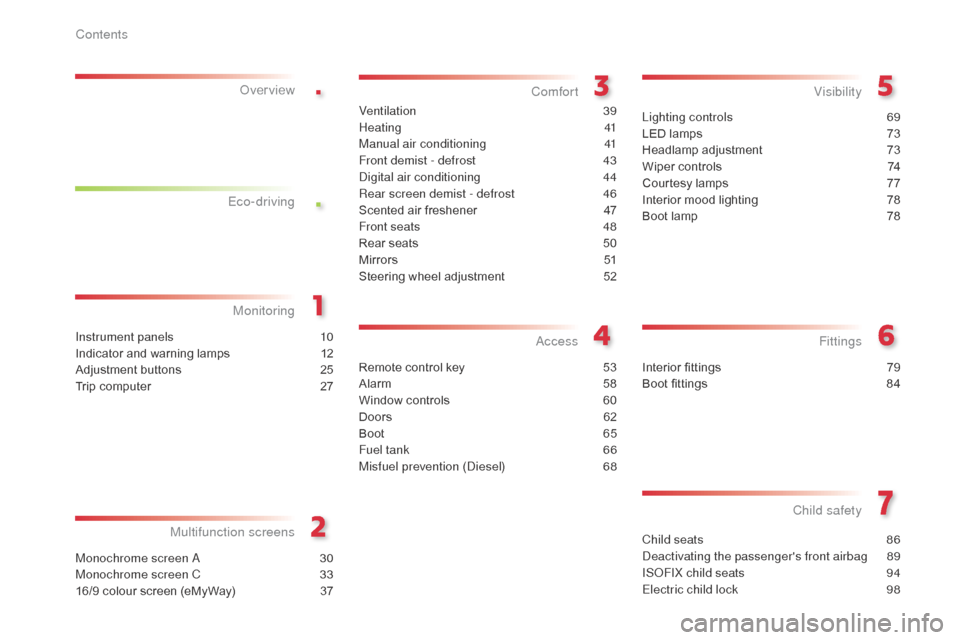
.
.
Child seats 86
dea
ctivating the passenger's front airbag
8
9
IS
oF
IX child seats
9
4
Electric child lock
9
8
Child safety
Instrument panels 10
Indicator and warning lamps
1
2
Adjustment buttons
2
5
Trip computer
2
7
MonitoringOver view
Monochrome screen a 3
0
Monochrome screen C
3
3
16/9 colour screen (eMyWay)
3
7
Multifunction screens
Ventilation 39
Heating
41
Manual air conditioning
4
1
Front demist - defrost
4
3
di
gital air conditioning
4
4
Rear screen demist - defrost
4
6
Scented air freshener
4
7
Front seats
4
8
Rear seats
5
0
M i r r o r s
51
S
teering wheel adjustment
5
2
Comfort
Remote control key 53
Alarm
5
8
Window controls
6
0
Doors
6
2
Boot
6
5
Fuel tank
6
6
Misfuel prevention (
die
sel)
6
8
access
Lighting controls 69
LED lamps
7
3
Headlamp adjustment
7
3
Wiper controls
7
4
Courtesy lamps
7
7
Interior mood lighting
7
8
Boot lamp
7
8
Visibility
Interior fittings 79
Boot fittings
8
4
Fittings
Eco-driving
Contents
Page 7 of 284
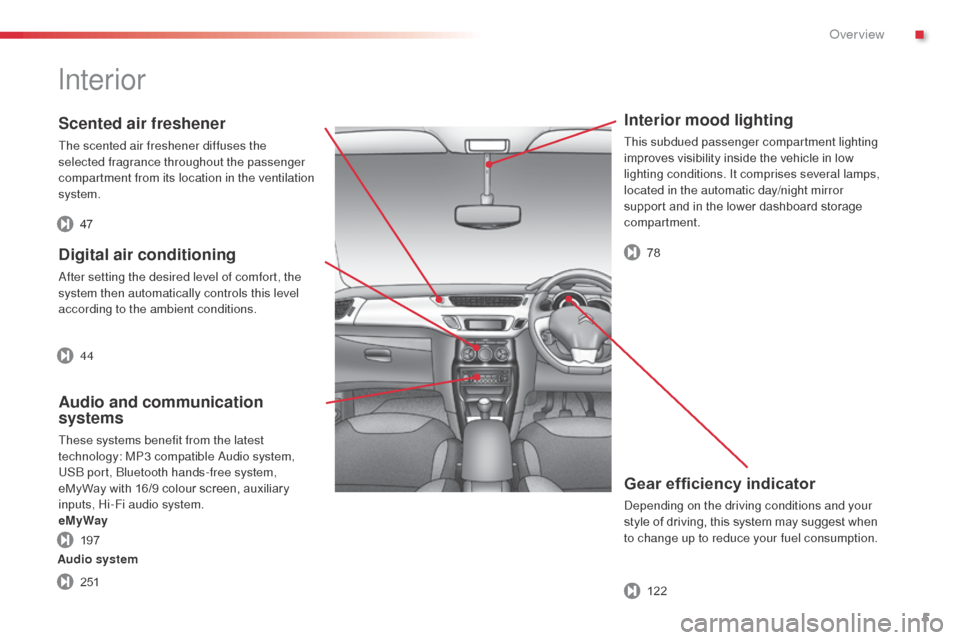
5
Interior mood lighting
This subdued passenger compartment lighting
improves visibility inside the vehicle in low
lighting conditions. It comprises several lamps,
located in the automatic day/night mirror
support and in the lower dashboard storage
compartment.
Gear efficiency indicator
depending on the driving conditions and your
style of driving, this system may suggest when
to change up to reduce your fuel consumption.
Scented air freshener
The scented air freshener diffuses the
selected fragrance throughout the passenger
compartment from its location in the ventilation
system.
Digital air conditioning
after setting the desired level of comfort, the
system then automatically controls this level
according to the ambient conditions.
Audio and communication
systems
These systems benefit from the latest
technology: MP3 compatible au dio system,
US
b
port, b
l
uetooth hands-free system,
eMyWay with 16/9 colour screen, auxiliary
inputs, Hi-Fi audio system.
eMyWay
Interior
78
47
197
2 51 44
12 2
Audio system
.
Over view
Page 9 of 284

7
Instruments and controls1. Steering wheel adjustment control.
2. Headlamp height adjustment.
3.
C
ruise control / speed limiter controls.
4.
L
ighting and direction indicator control
stalk.
5.
Microphone.
6.
C
entral locking button.
7.
M
ultifunction screen.
8.
H
azard warning lamps button.
9.
C
entral adjustable air vents.
10.
S
unshine sensor
H
i-Fi audio system central speaker.
11.
P
assenger's airbag.
12 .
G
love box / Passenger's airbag
deactivation / Fusebox.
13.
b
o
nnet release lever.
14 .
1
2 V accessory socket
U
S
b
port / auxiliary socket.
15.
U
pper and lower storage.
16.
a
u
dio system or eMyWay.
17.
H
eating / air conditioning controls.
.
over view
Page 10 of 284
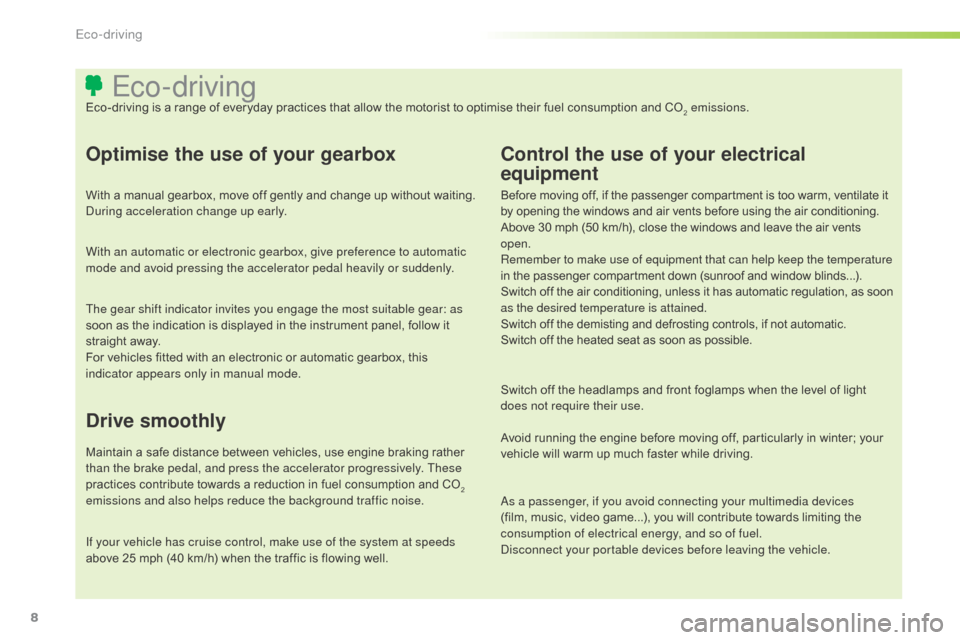
8
Eco-drivingEco-driving is a range of everyday practices that allow the motorist to optimise their fuel consumption and CO2 emissions.
Optimise the use of your gearbox
With a manual gearbox, move off gently and change up without waiting. during acceleration change up early.
With an automatic or electronic gearbox, give preference to automatic
mode and avoid pressing the accelerator pedal heavily or suddenly.
Drive smoothly
Maintain a safe distance between vehicles, use engine braking rather
than the brake pedal, and press the accelerator progressively. These
practices contribute towards a reduction in fuel consumption and CO
2
emissions and also helps reduce the background traffic noise.
If your vehicle has cruise control, make use of the system at speeds
above 25 mph (40 km/h) when the traffic is flowing well. The gear shift indicator invites you engage the most suitable gear: as
soon as the indication is displayed in the instrument panel, follow it
straight away.
For vehicles fitted with an electronic or automatic gearbox, this
indicator appears only in manual mode.
Control the use of your electrical
equipment
Before moving off, if the passenger compartment is too warm, ventilate it
by opening the windows and air vents before using the air conditioning.
Above 30 mph (50 km/h), close the windows and leave the air vents
open.
Remember to make use of equipment that can help keep the temperature
in the passenger compartment down (sunroof and window blinds...).
Switch off the air conditioning, unless it has automatic regulation, as soon
as the desired temperature is attained.
Switch off the demisting and defrosting controls, if not automatic.
Switch off the heated seat as soon as possible.
Switch off the headlamps and front foglamps when the level of light
does not require their use.
Avoid running the engine before moving off, particularly in winter; your
vehicle will warm up much faster while driving.
as a p
assenger, if you avoid connecting your multimedia devices
(film, music, video game...), you will contribute towards limiting the
consumption of electrical energy, and so of fuel.
dis
connect your portable devices before leaving the vehicle.
Eco-driving
Page 41 of 284
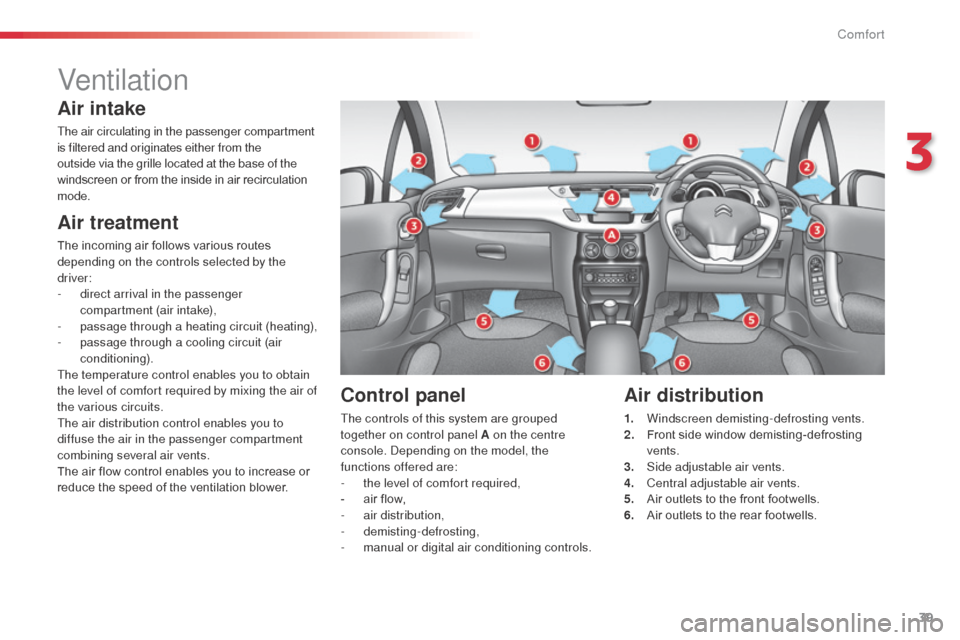
39
Ventilation
Air intake
The air circulating in the passenger compartment
is filtered and originates either from the
outside via the grille located at the base of the
windscreen or from the inside in air recirculation
mode.
Air treatment
The incoming air follows various routes
depending on the controls selected by the
driver:
-
d
irect arrival in the passenger
compartment (air intake),
-
p
assage through a heating circuit (heating),
-
p
assage through a cooling circuit (air
conditioning).
The temperature control enables you to obtain
the level of comfort required by mixing the air of
the various circuits.
The air distribution control enables you to
diffuse the air in the passenger compartment
combining several air vents.
The air flow control enables you to increase or
reduce the speed of the ventilation blower.
Control panel
The controls of this system are grouped
together on control panel A on the centre
console.
d
e
pending on the model, the
functions offered are:
-
t
he level of comfort required,
-
a
ir flow,
-
a
ir distribution,
-
demisting-defrosting,
-
m
anual or digital air conditioning controls.
Air distribution
1. Windscreen demisting-defrosting vents.
2. Front side window demisting-defrosting
vents.
3.
S
ide adjustable air vents.
4.
C
entral adjustable air vents.
5.
A
ir outlets to the front footwells.
6.
A
ir outlets to the rear footwells.
3
Comfort
Page 42 of 284

40
If after an extended stop in sunshine,
the interior temperature is very
high, first ventilate the passenger
compartment for a few moments.
Put the air flow control at a setting high
enough to quickly change the air in the
passenger compartment.
The air conditioning system does not
contain chlorine and does not present
any danger to the ozone layer.The condensation created by the air
conditioning results in a discharge
of water under the vehicle which is
perfectly normal.Recommendations for ventilation and
air conditioning
In order for these systems to be fully effective, follow the operation and maintenance
guidelines below:
F
T
o obtain an even air distribution, take care not to obstruct the exterior air intake grilles
located at the base of the windscreen, the nozzles, the vents and the air outlets, as well
as the air extractor located in the boot.
F
D
o not cover the sunshine sensor, located on the dashboard; this is used for regulation
of the air conditioning system.
F
O
perate the air conditioning system for at least 5 to 10 minutes, once or twice a month
to keep it in per fect working order.
F
E
nsure that the passenger compartment filter is in good condition and have the filter
elements replaced regularly.
W
e recommend the use of a combined passenger compartment filter. Thanks to its
special active additive, it contributes to the purification of the air breathed by the
occupants and the cleanliness of the passenger compartment (reduction of allergic
symptoms, bad odours and greasy deposits).
F
T
o ensure correct operation of the air conditioning system, you are also advised to have
it checked regularly as recommended in the maintenance and warranty guide.
F
I
f the system does not produce cold air, switch it off and contact a CITROËN dealer or a
qualified workshop.
When towing the maximum load on a steep gradient in high temperatures, switching off the
air conditioning increases the available engine power and so improves the towing ability.
Comfort
Page 43 of 284

41
Heating / VentilationManual air
conditioning
The heating / ventilation or air conditioning
systems operates with the engine running,
as well as in STOP mode with Stop & Start.
1. Temperature adjustment
2. Air flow adjustment
F Turn the dial from blue
(cold) to red (hot) to adjust
the temperature to your
requirements.
F
T
urn the dial from position 1
to position 5 to obtain a
comfortable air flow.
Manual control panel
Electric control panel Manual control panel
Electric control panel
F If you place the air flow control
in position 0 (deactivation of the
system), the temperature is no
longer maintained at a comfortable
level. However, a slight flow of air,
due to the movement of the vehicle,
can still be felt.
3
Comfort
Page 44 of 284
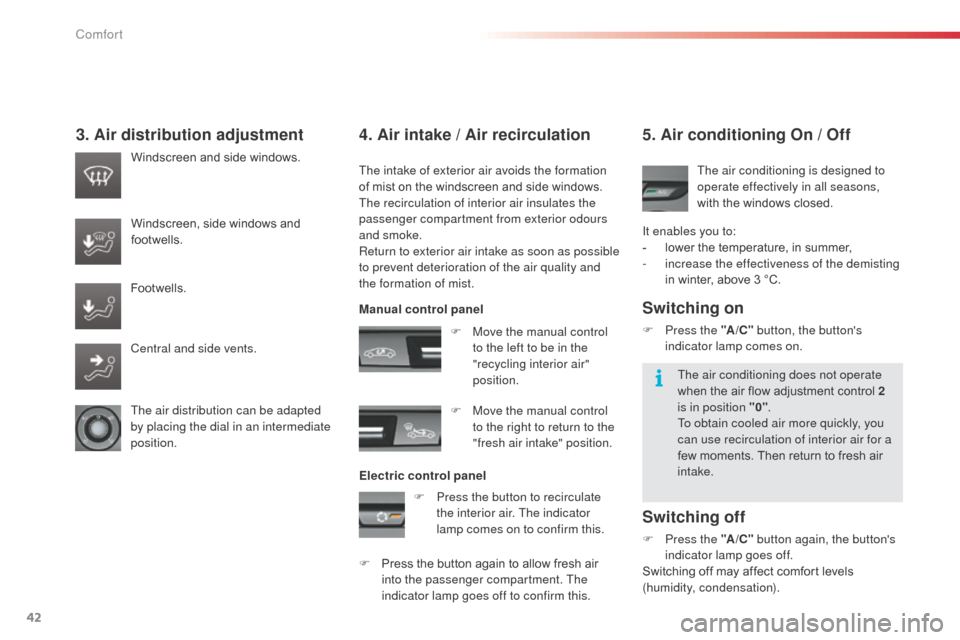
42
3. Air distribution adjustment
The intake of exterior air avoids the formation
of mist on the windscreen and side windows.
The recirculation of interior air insulates the
passenger compartment from exterior odours
and smoke.
Return to exterior air intake as soon as possible
to prevent deterioration of the air quality and
the formation of mist.
Windscreen and side windows.
Windscreen, side windows and
footwells.
Footwells.
Central and side vents.
The air distribution can be adapted
by placing the dial in an intermediate
position. F
M
ove the manual control
to the left to be in the
"recycling interior air"
position.
F
M
ove the manual control
to the right to return to the
"fresh air intake" position.
Manual control panel
Electric control panel
F
P
ress the button to recirculate
the interior air. The indicator
lamp comes on to confirm this.
F
P
ress the button again to allow fresh air
into the passenger compartment. The
indicator lamp goes off to confirm this.
5. Air conditioning On / Off
Switching off
F Press the "A /C " button again, the button's
indicator lamp goes off.
Switching off may affect comfort levels
(humidity, condensation). The air conditioning is designed to
operate effectively in all seasons,
with the windows closed.
It enables you to:
-
l
ower the temperature, in summer,
-
i
ncrease the effectiveness of the demisting
in winter, above 3 °C.
Switching on
F Press the "A /C " button, the button's
indicator lamp comes on.
The air conditioning does not operate
when the air flow adjustment control 2
is in position "0" .
To obtain cooled air more quickly, you
can use recirculation of interior air for a
few moments. Then return to fresh air
intake.
4. Air intake / Air recirculation
Comfort
Page 45 of 284
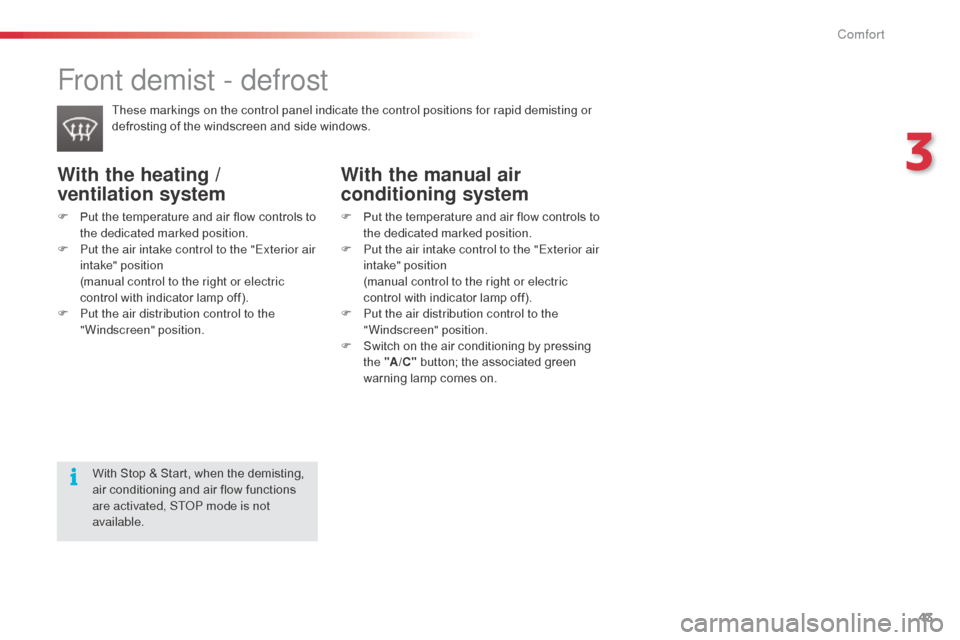
43
With the heating /
ventilation system
F Put the temperature and air flow controls to the dedicated marked position.
F
P
ut the air intake control to the "Exterior air
intake" position
(
manual control to the right or electric
control with indicator lamp off).
F
P
ut the air distribution control to the
"Windscreen" position.
Front demist - defrost
These markings on the control panel indicate the control positions for rapid demisting or
defrosting of the windscreen and side windows.
With the manual air
conditioning system
F Put the temperature and air flow controls to the dedicated marked position.
F
P
ut the air intake control to the "Exterior air
intake" position
(
manual control to the right or electric
control with indicator lamp off).
F
P
ut the air distribution control to the
"Windscreen" position.
F
S
witch on the air conditioning by pressing
the "A /C " button; the associated green
warning lamp comes on.
With Stop & Start, when the demisting,
air conditioning and air flow functions
are activated, ST
oP m
ode is not
available.
3
Comfort
Page 46 of 284
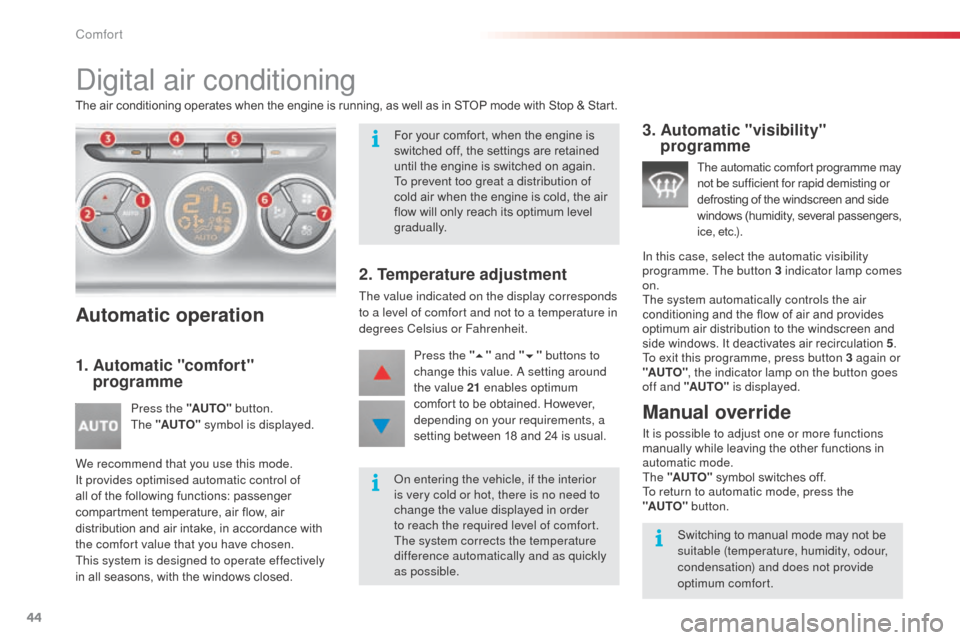
44
digital air conditioning
The air conditioning operates when the engine is running, as well as in STOP mode with Stop & Start.
Automatic operation
1. Automatic "comfort" programme
Press the "AUTO" button.
The "AUTO" symbol is displayed.
We recommend that you use this mode.
It provides optimised automatic control of
all of the following functions: passenger
compartment temperature, air flow, air
distribution and air intake, in accordance with
the comfort value that you have chosen.
This system is designed to operate effectively
in all seasons, with the windows closed.
2. Temperature adjustment
The value indicated on the display corresponds
to a level of comfort and not to a temperature in
degrees Celsius or Fahrenheit. Press the " 5" and " 6" buttons to
change this value.
a setting around
the value 21 enables optimum
comfort to be obtained. However,
depending on your requirements, a
setting between 18 and 24 is usual.
3. Automatic "visibility" programme
The automatic comfort programme may
not be sufficient for rapid demisting or
defrosting of the windscreen and side
windows (humidity, several passengers,
i c e , e t c .) .
In this case, select the automatic visibility
programme. The button 3 indicator lamp comes
on.
The system automatically controls the air
conditioning and the flow of air and provides
optimum air distribution to the windscreen and
side windows. It deactivates air recirculation 5 .
To exit this programme, press button 3 again or
"AUTO" , the indicator lamp on the button goes
off and "AUTO" is displayed.
Manual override
It is possible to adjust one or more functions
manually while leaving the other functions in
automatic mode.
The "AUTO" symbol switches off.
To return to automatic mode, press the
"AUTO"
button.
For your comfort, when the engine is
switched off, the settings are retained
until the engine is switched on again.
To prevent too great a distribution of
cold air when the engine is cold, the air
flow will only reach its optimum level
gradually.
on e
ntering the vehicle, if the interior
is very cold or hot, there is no need to
change the value displayed in order
to reach the required level of comfort.
The system corrects the temperature
difference automatically and as quickly
as possible. Switching to manual mode may not be
suitable (temperature, humidity, odour,
condensation) and does not provide
optimum comfort.
Comfort